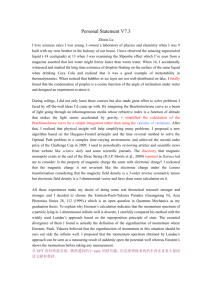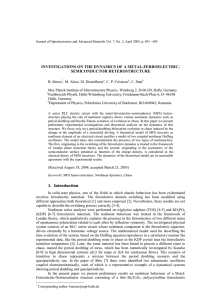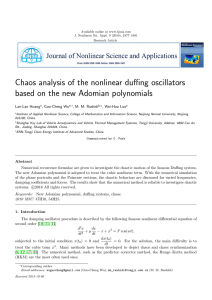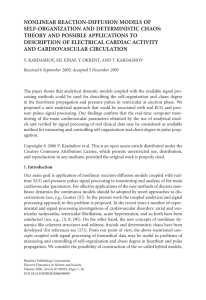Nonlinear Dynamics and Complex Systems
advertisement
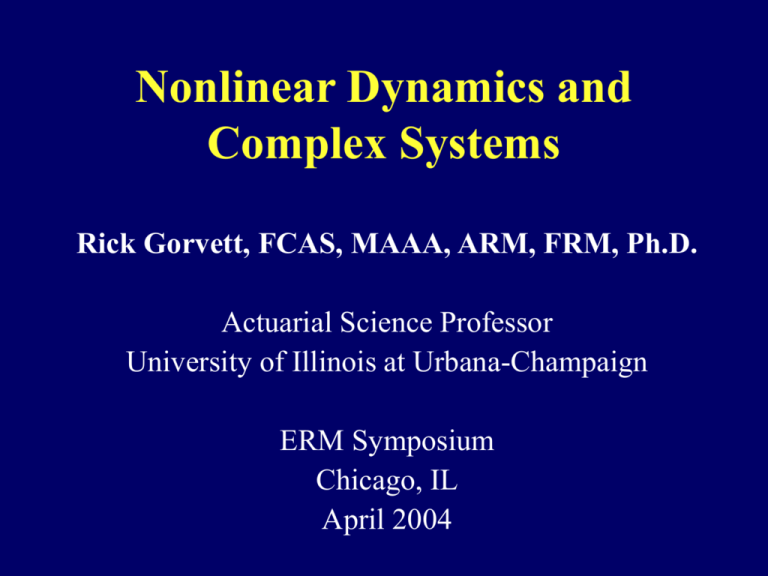
Nonlinear Dynamics and Complex Systems Rick Gorvett, FCAS, MAAA, ARM, FRM, Ph.D. Actuarial Science Professor University of Illinois at Urbana-Champaign ERM Symposium Chicago, IL April 2004 Agenda • • • • • • • Purpose and framework Historical background Chaos and complexity Nonlinear modeling techniques Sample references Contact information Questions / ideas / suggestions Purpose and Framework • What this presentation is – Description of historical evolution – An overview of concepts – Hopefully, inspirational • What this presentation is not – A cookbook of tried-and-true formulas – An encyclopedia of applications • This material is much more a way of thinking than rote application of equations and techniques Purpose and Framework (cont.) A Personal Anecdote • Some common student questions – – – – “Will this be on the exam?” “Is the final cumulative?” “What do I say at an interview?” “How do I decide between casualty and life?” • One particular (very good) student asked recently – “How do I know I won’t get bored with being an actuary,” which morphed into – “Where is the beauty in actuarial science?” Purpose and Framework (cont.) The “Beauty” in Actuarial Science • Virtually everything can be considered to be relevant to actuarial science – Economic and financial conditions – Social, political, and religious conditions and trends – Science, technology, medicine • In a fast-changing, dynamic world, the profession must also evolve and adapt to the underlying factors Historical Background • Plato (427-347 BC) – Forms, Ideas, Ideals – Eternal, absolute, unchanging – Outside the sense-world • Pythagoras (570-490 BC) – Leader of a religious sect – Numbers are primary – Relationship between plucked string length and the resulting musical note – Pythagorean theorem, etc. Historical Background (cont.) • Euclid (c. 300 BC) – Compiled mathematical thought into his Elements – Systematized theorem and methodology of proof, as well as geometric reasoning (which held primacy until quite recently) • Ptolemy (c. 140 AD) – Astronomer: wrote the Almagest (“The Greatest”) – Geocentric universe – Complicated system of circles (deferents, epicycles, eccentrics, etc.) Historical Background (cont.) • Copernicus (1473-1543 AD) – Heliocentric universe – Planetary movements still circular – Complicated: 48 cycles and epicycles • Kepler (1571-1630 AD) – Originally tried to place planetary orbits within a framework of “nested solids” – Ultimately, determined that planets orbit according to ellipses Historical Background (cont.) • Nineteenth-century – Non-Euclidean geometry: space need not be “flat” • Twentieth-century – Relativity: space-time is warped by matter and energy – Quantum mechanics: probabilistic; breakdown of causality principle So…. • We naturally (and/or have been conditioned to) love and accept – Linearity – Smoothness – Stability • This, in the face of a world that is largely – Nonlinear – Unsmooth – Random Chaos • Random results from simple equations OR • Finding order in random results • Sensitivity to initial conditions – Butterfly effect – Measurement issues (parameter uncertainty) • Local randomness vs. global stability • Deterministic – not total disorder Chaos (cont.) • Consider a non-linear time series – E.g., it can converge, enter into periodic motion, or enter into chaotic motion • Example: the logistic function xt+1 = a xt (1-xt) – Stability depends upon the coefficient value – Note: no noise or chaotic provision built into rule Sante Fe Institute • • • • • Founded in 1984 Private, non-profit Multidisciplinary research and education Primarily a “visiting” institution Current research focus areas – – – – – – Cognitive neuroscience Computation in physical and biological systems Economic and social interactions Evolutionary dynamics Network dynamics Robustness Complexity • A commonly heard definition: “the edge of chaos” – Between order and randomness • Simple rules can lead to complex systems • Related to “entropy” – Entropy = disorder – Second law of thermodynamics Quotation Nonlinear Dynamics and Chaos: Where do we go from here? (Preface) “This book was born out of the lingering suspicion that the theory and practice of dynamical systems had reached a plateau of development…. The over-riding message is clear: if dynamical systems theory is to make a significant long-term impact, it needs to get smart, because most systems are illdefined….” Quotation War and Peace, by Leo Tolstoy Book Eleven, Chapter 1 “Only by taking infinitesimally small units for observation (the differential of history, that is, the individual tendencies of men) and attaining to the art of integrating them (that is, finding the sum of these infinitesimals) can we hope to arrive at the laws of history.” Quotation (cont.) War and Peace, by Leo Tolstoy Second Epilogue, Chapter 9 “All cases without exception in which our conception of freedom and necessity is increased and diminished depend on three considerations: (1) The relation to the external world of the man who commits the deeds. (2) His relation to time. (3) His relation to the causes leading to the action.” Quotation (cont.) War and Peace, by Leo Tolstoy Second Epilogue, Chapter 11 “And if history has for its object the study of the movement of the nations and of humanity and not the narration of episodes in the lives of individuals, it too, …, should seek the laws common to all the inseparably interconnected infinitesimal elements of free will.” Fractal Geometry and Analysis • Think of a tree – Picture from a distance, or – A drawing or representation of a tree • Move closer – Individual branches and patterns are unique • Quote from Peters (1994): “Euclidean geometry cannot replicate a tree…. Euclidean geometry recreates the perceived symmetry of the tree, but not the variety that actually builds its structure. Underlying this perceived symmetry is a controlled randomness, and increasing complexity at finer levels of resolution.” Finance and Economics • Traditional (“classical”) paradigm – Random walk – Efficient markets hypothesis – Rational behavior • Emerging paradigm – Behavioral and utility issues – Possible path-dependence – Learning from experience Fractal Market Hypothesis • Behavioral issues – Importance of liquidity and investors’ horizons • Investment horizons – If there are a large number of traders with many investment horizons in the aggregate, the longerhorizon traders can provide liquidity to the shorthorizon traders when the latter experience a significant event (e.g., crash, discontinuity) Nonlinear Modeling Techniques • Neural networks • Genetic algorithms • Fuzzy logic We will discuss • Others (e.g., mentioned by Shapiro (2000)) – – – – Statistical pattern recognition Simulated annealing Rule induction Case-based reasoning Neural Networks • Artificial intelligence model • Characteristics: – – – – Pattern recognition / reconstruction ability Ability to “learn” Adapts to changing environment Resistance to input noise • Bottom line: – Data is input – Behavior is output Neural Networks (cont.) • Process – Data (neurons) input into the network – Weights are assigned – Weights are changed until output is “optimal” • Brockett, et al (1994) – Feed forward / back propagation – Predictability of insurer insolvencies Genetic Algorithms • Inspired by biological evolutionary processes • Iterative process – Start with an initial population of “solutions” (think: chromosomes) – Evaluate fitness of solutions – Allow for evolution of new (and potentially better) solution populations • E.g., via “crossover,” “mutation” – Stop when “optimality” criteria are satisfied Fuzzy Set Theory Insurance Problems • Risk classification – Acceptance decision, pricing decision – Few versus many class dimensions – Many factors are “clear and crisp” • Pricing – Class-dependent – Incorporating company philosophy / subjective information Fuzzy Set Theory (cont.) A Possible Solution • Provide a systematic, mathematical framework to reflect vague, linguistic criteria • Instead of a Boolean-type bifurcation, assigns a membership function: For fuzzy set A, mA(x): X ==> [0,1] • Young (1996, 1997): pricing (WC, health) • Cummins & Derrig (1997): pricing • Horgby (1998): risk classification (life) Some Other Techniques • Agent-based modeling – Simple agents + simple rules societies • Cellular automata – Start with simple set of rules – Can produce complex and interesting patterns • Percolation theory – Lattice – Probability associated with “yes” or “no” in each cell of the lattice – Clustering and pathways Sample References • Casti, 2003, “Money is Funny, or Why Finance is Too Complex for Physics,” Complexity, 8(2): 14-18 • Craighead, 1994, “Chaotic Analysis on U.S. Treasury Interest Rates,” 4th AFIR International Colloquium, pp. 497-536 • Hogan, et al, eds., 2003, Nonlinear Dynamics and Chaos: Where do we go from here?, Institute of Physics Publishing • Horgan, 1995, “From Complexity to Perplexity,” Scientific American, 272(6): p. 104 • Peters, 1994, Fractal Market Analysis: Applying Chaos Theory to Investment and Economics, John Wiley & Sons • Shapiro, 2000, “A Hitchhiker’s Guide to the Techniques of Adaptive Nonlinear Models,” Insurance: Mathematics & Economics, 26: 119-132 For a Copy of the Presentation • E-mail: gorvett@uiuc.edu • Web page: http://www.math.uiuc.edu/~gorvett/

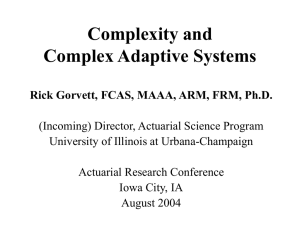



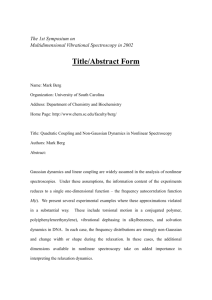

![科目名 Course Title Biophysics(生物物理工学E) [Biophysics] 講義](http://s3.studylib.net/store/data/006875691_1-037c7ffb9d75e651250ec104bd31557f-300x300.png)
